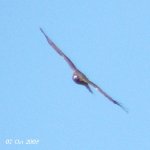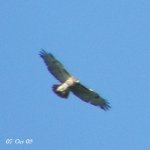deborahp
Well-known member
While out stalking wild turkeys with a point-and-shoot (Fuji S5100) + Tcon 17, I couldn't resist trying to catch this red-tailed hawk soaring overhead hundreds of feet away. I'm fairly certain on the ID, I got the top of its bright red tail in another shot.
Couldn't keep up with it with auto-single, auto-continuous, or manual focus. I'm wondering if I made a mistake in ordering a 70-300mm instead of a 170-500mm (for a D70s) to learn to photograph birds flying overhead, since I could barely make out the the focusing through the EVF.
Is the bird you see through the viewfinder appreciably larger looking through a 500mm vs. a 300mm... enough to be more helpful focusing?
Couldn't keep up with it with auto-single, auto-continuous, or manual focus. I'm wondering if I made a mistake in ordering a 70-300mm instead of a 170-500mm (for a D70s) to learn to photograph birds flying overhead, since I could barely make out the the focusing through the EVF.
Is the bird you see through the viewfinder appreciably larger looking through a 500mm vs. a 300mm... enough to be more helpful focusing?





